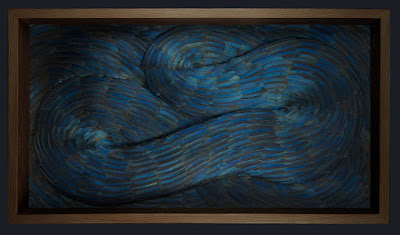| Kate MccGwire, Covert, 2014 |
I had resisted going to see this exhibition because the
image in the publicity material (Covert) is so creepy. The feather-covered organic form
curling around and under itself reminded me of a swan with its head tucked
inside its plumage, busy cleaning. Why is that creepy? Because there is no
head, claws, or any other body part that might make the form resemble a bird.
Add to this that what I thought was a bell jar, but is actually an antique
glass dome, is placed over the top and appears to suffocate the “bird.” Face to
face, the object is no less unsettling, but it is also infinitely more complex
than my response of repulsion would allow for. The meticulously made feathered
object sits on a bed of bones that are—somehow—at one and the same time
comfortable and violating. The feathers are so sensual that I wanted to stroke
them, and yet, as the press release suggests, they are so alive and fresh that
it feels as though the creature will break out of its glass dome any minute. I
couldn’t help being reminded of Hitchcock’s Birds:
the threat that always looms large in the presence of these uncanny creatures.
| Kate MccGwire, Scissure (Breach), 2014 |
To me, MccGwire’s work is not only erotic, but another
dimension that makes it both compelling, disturbing, frightening and powerful
is that it is all about violence and subjugation of women. There’s nothing
written about this in the material I glanced at, but it’s difficult to look at Pelt or Sissure and not see vaginal imagery. The small cut bones that line
the incision in leather or a feather down are vagina dentate, about to consume
whatever comes near them. But even the less obvious imagery reminded me of
women being beaten. The soft sensuous curves of other pieces, tightly coiled to
protect themselves from their oppressor, or cowering in the face of abuse—it’s
hard to tell which—have titles such as Submit,
Succumb, Pervade, and Acquiesce.
To me the impossibility of the forms, the resilience of the feathers, the holes
and incisions, the purity of the white figures, are all qualities that reveal
the complexity and irresolveability of what it is to be a woman faced with
violence. Even the squashing of Covert
with the dome is a case of the making small and the oppression which can only
be made to women. The forms are so obviously birds that cannot fly, whose wings
have been cut, whose energy has been contained. The beauty and disgust of
women’s body – the splendour and the fear of its power—are quelled again and
again in MccGwire’s sculptures.
.jpg?format=1000w) |
| Kate MccGwire window display in Ginza Maison Hermès |
The forms also fly between science and art, between culture
and nature – never settling on one side or the other. Unsurprisingly, MccGwire’s
work has been exhibited at the Musée de la Chasse and Natural History museums.
These spaces would seem ideal locations for work that transgresses all
boundaries between museum display and scientific curiosity. As objects in a
gallery they are most strikingingly sculptures, but in their antique domes,
they are also scientific displays or even curiosities. And the fact that she
had a piece in the window of the Hermes store in Japan sees it move into
discourses on consumerism as a mass of feathers spreads like a monster into the
display window. Although very different in their movement and delivery of the
threat, their monstrosity raises the Hitchcock reference again. However, unlike
Hitchcokc’s birds MccGwire’s are still trapped, caught in the moment of
anticipation where we are sure they are about to morph.
There is something about the liveness of the feathers, that
makes them always transforming. I think it’s also the coil like nature of the
forms, the way they wrap themselves into knots as though they are in pain,
contorting their bodies out of fear and anxiety. We too then feel this anxiety.
MccGwire also talks in interview about wanting to make us see the birds
differently: pigeons, crows, geese, and other birds we love to hate to varying
degrees are all transformed here. By showing their brilliantly coloured or
perfect white plumage, we are attracted to creatures we otherwise detest. And
in the viscerality of our response, we cannot forget them, and yet, we don’t
want to keep these uncanny creatures hanging around in our conscious or
unconscious minds for fear of what they might turn into at any moment.
Images Courtesy The Artist

No comments:
Post a Comment